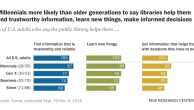Our library engagement typology found that Americans fall into four broad levels of engagement with public libraries, which can further be divided into nine total groups. (Want to see which group you fall into? Take our library user type quiz to find out!)
But how common are these groups in urban, suburban, and rural areas?1

Print Traditionalists, a medium-engagement group, are far more likely to live in rural areas than any other group, and account for one in five rural residents. Meanwhile, the low-engagement Young and Restless group, along with the highly-engaged Information Omnivores, are more likely than most others to live in urban areas, and are relatively scarce in rural communities. Finally, looking at our two non-engagement groups (comprised of people who have never used a public library), we see that suburban and rural areas also contain higher proportions of Distant Admirers, while urban areas contain higher proportions of those Off the Grid.
Update: Here’s how that same chart looks by overall levels of library engagement (high/medium/low/none):

So what’s going on here? A lot of it boils down to demographics. We know, for instance, that people living in rural areas tend to have lower levels of education and are more likely to be older than those who live in urban or suburban areas—all factors that are associated with lower levels of library engagement.

Similarly, people living in urban areas are more likely to be in younger age groups than those in other community types, and those living in suburban areas are more likely to have higher levels of household income—both features that are associated with higher levels of library engagement.
What sort of library users (or non-users) are in your community? Click here to learn more about how to create a library user type quiz for your community or group.



